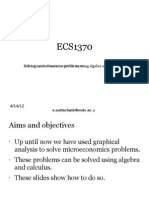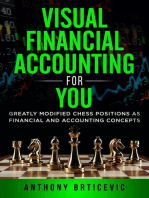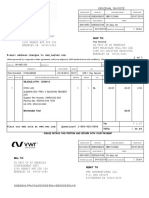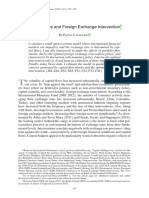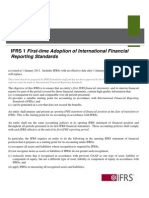Ans 12
Ans 12
Uploaded by
Jenny WijayaCopyright:
Available Formats
Ans 12
Ans 12
Uploaded by
Jenny WijayaOriginal Title
Copyright
Available Formats
Share this document
Did you find this document useful?
Is this content inappropriate?
Copyright:
Available Formats
Ans 12
Ans 12
Uploaded by
Jenny WijayaCopyright:
Available Formats
Answer Key for Chapter 12
Exercises:
3. A monopolist can produce at a constant average (and marginal) cost of AC = MC = $5. It faces a market demand curve given b ! = 53 " #. a. Calculate t$e profit%ma&imi'ing price and (uantit for t$is
monopolist. Also calculate its profits. First solve for the inverse demand curve, P = 53 Q. Then the
marginal revenue curve has the same intercept and twice the slope: MR = 53 2Q. Marginal cost is a constant "uantit#: 53 2Q = 5, or Q = 2$. !u%stitute Q = 2$ into the demand function to find price: P = 53 2$ = 2&. 'ssuming fi(ed costs are )ero, profits are e"ual to = TR TC = *2&+*2$+ *5+*2$+ = 5,-. b. )uppose a second firm enters t$e market. *et !+ be t$e output of t$e first firm and !, be t$e output of t$e second. Market demand is no- given b !+ . !, = 53 " #. Assuming t$at t$is second firm $as t$e same costs as t$e first/ -rite t$e profits of eac$ firm as functions of !+ and !,. .hen the second firm enters, price can %e written as a function of the output of %oth firms: P = 53 Q/ Q2. .e ma# write the profit functions for the two firms:
2 1 = PQ1 C (Q1 ) = (53 Q1 Q2 )Q1 5Q1 , or 1 = 48Q1 Q1 Q1Q2
5. !etting MR = MC, find the optimal
and
2 2 = PQ2 C(Q2 ) = (53 Q1 Q2 )Q2 5Q2 , or 2 = 48Q2 Q2 Q1Q2 .
c. )uppose (as in t$e Cournot model) t$at eac$ firm c$ooses its profit% ma&imi'ing level of output on t$e assumption t$at its competitor0s output is fi&ed. 1ind eac$ firm0s 2reaction curve3 (i.e./ t$e rule t$at gives its desired output in terms of its competitor0s output). 0nder the 1ournot assumption, each firm treats the output of the other firm as a constant in its ma(imi)ation calculations. Therefore, Firm / chooses Q/ to ma(imi)e / in part *%+ with Q2 %eing treated as a constant. The change in / with respect to a change in Q/ is
1 = 48 2Q1 Q2 = 0 , or Q1 = 24 Q2 . Q1 2
This e"uation is the reaction function for Firm /, which generates the profit2 ma(imi)ing level of output, given the output of Firm 2. 3ecause the pro%lem is s#mmetric, the reaction function for Firm 2 is
Q2 = 24
Q1 . 2
d. Calculate t$e Cournot e(uilibrium (i.e./ t$e values of ! + and !, for -$ic$ eac$ firm is doing as -ell as it can given its competitor0s output). firm5 !olve for the values of Q/ and Q2 that satisf# %oth reaction functions %# su%stituting Firm 24s reaction function into the function for Firm /: 4$at are t$e resulting market price and profits of eac$
1 Q1 Q1 = 24 24 , or Q1 = 16. 2 2
3# s#mmetr#, Q2 = /-. To determine the price, su%stitute Q/ and Q2 into the demand e"uation: P = 53 /- /- = 2/. 5rofit for Firm / is therefore
i = PQi C*Qi+ = i = *2/+*/-+ *5+*/-+ = 25-.
Firm 24s profit is the same, so total industr# profit is / 6 2 = 25- 6 25- = 5/2.
6. 7$is e&ercise is a continuation of 8&ercise 3. 4e return to t-o firms -it$ t$e same constant average and marginal cost/ AC = MC = 5/ facing t$e market demand curve Q+ . Q, = 53 " P. its output decision before t$e ot$er. a. )uppose 1irm + is t$e )tackelberg leader (i.e./ makes its output decisions before 1irm ,). 1ind t$e reaction curves t$at tell eac$ firm $o- muc$ to produce in terms of t$e output of its competitor. Firm 24s reaction curve is the same as determined in part *c+ of 7(ercise 3: Q2 = 24 Q1 2 . 9o- -e -ill use t$e )tackelberg model to anal 'e -$at -ill $appen if one of t$e firms makes
Firm / does not have a reaction function %ecause it ma8es its output decision %efore Firm 2, so there is nothing to react to. 9nstead, Firm / uses its 8nowledge of Firm 24s reaction function when determining its optimal output as shown in part *%+ %elow. b. :o- muc$ -ill eac$ firm produce/ and -$at -ill its profit be5 Firm /, the !tac8el%erg leader, will choose its output, Q/, to ma(imi)e its profits, su%:ect to the reaction function of Firm 2: ma( / = PQ/ C*Q/+, su%:ect to Q2 = 24 Q1 2 .
!u%stitute for Q2 in the demand function and, after solving for P, su%stitute for P in the profit function:
max 1 = 53 Q1 24
Q1 2
(Q1 ) 5Q1 .
To determine the profit2ma(imi)ing "uantit#, we find the change in the profit function with respect to a change in Q/: d / = 53 2 Q/ 2$ + Q/ 5. dQ / !et this e(pression e"ual to ; to determine the profit2ma(imi)ing "uantit#:
53 2Q/ 2$ 6 Q/ 5 = ;, or Q/ = 2$. !u%stituting Q/ = 2$ into Firm 24s reaction function gives Q2: Q2 = 2$ 2$ = /2. 2
!u%stitute Q/ and Q2 into the demand e"uation to find the price: P = 53 2$ /2 = /,.
5rofits for each firm are e"ual to total revenue minus total costs, or / = */,+*2$+ *5+*2$+ = 2<<, and 2 = */,+*/2+ *5+*/2+ = /$$. Total industr# profit, T = / 6 2 = 2<< 6 /$$ = $32. 1ompared to the 1ournot e"uili%rium, total output has increased from 32 to 3-, price has fallen from 2/ to /,, and total profits have fallen from 5/2 to $32. 5rofits for Firm / have risen from 25- to 2<<, while the profits of Firm 2 have declined sharpl# from 25- to /$$.
;.
)uppose t$at t-o identical firms produce -idgets and t$at t$e firms in t$e market. 7$eir costs are given b
are
t$e onl
C+ = ;<!+ and C, =
;<!,/ -$ere !+ is t$e output of 1irm + and !, t$e output of 1irm ,. #rice is determined b t$e follo-ing demand curve= # = 3<< " ! -$ere ! = !+ . !,. a. 1ind t$e Cournot%9as$ e(uilibrium. firm at t$is e(uilibrium. 5rofit for Firm /, TR/ 2 TC/, is e"ual to
1 2 2 = 3 0 0 Q Q Q Q 6 0 Q = 2 4 0 Q Q Q Q . 1 1 1 2 1 1 1 1 2
Calculate t$e profit of eac$
Therefore,
1 = 2 4 0 2 Q Q . 1 2 Q 1
4
!etting this e"ual to )ero and solving for Q/ in terms of Q2: Q/ = /2; ;.5Q2. This is Firm /4s reaction function. 3ecause Firm 2 has the same cost structure, Firm 24s reaction function is Q2 = /2; ;.5Q/ . !u%stituting for Q2 in the reaction function for Firm /, and solving for Q/, we find Q/ = /2; *;.5+*/2; ;.5Q/+, or Q/ = <;. 3# s#mmetr#, Q2 = <;. !u%stituting Q/ and Q2 into the demand
e"uation to determine the e"uili%rium price: P = 3;; <; <; = /$;. !u%stituting the values for price and "uantit# into the profit functions, / = */$;+*<;+ *-;+*<;+ = -$;;, and 2 = */$;+*<;+ *-;+*<;+ = -$;;. Therefore, profit is e"uili%rium. -$;; for %oth firms in the 1ournot2=ash
b. Suppose the two firms form a cartel to maximize joint profits. How many wi !ets will be pro uce " #alculate each firm$s profit.
>iven the demand curve is 5 = 3;; ?, the marginal revenue curve is M@ = 3;; 2?. 5rofit will %e ma(imi)ed %# finding the level of output such that marginal revenue is e"ual to marginal cost: 3;; 2? = -;, or ? = /2;. .hen total output is /2;, price will %e /<;, %ased on the demand
curve. !ince %oth firms have the same marginal cost, the# will split the total output e"uall#, so the# each produce -; units. 5rofit for each firm is: = /<;*-;+ -;*-;+ = ,2;;.
c. )uppose 1irm + -ere t$e onl above5
firm in t$e industr .
:o- -ould
market output and 1irm +0s profit differ from t$at found in part (b)
9f Firm / were the onl# firm, it would produce where marginal revenue is e"ual to marginal cost, as found in part *%+. 9n this case Firm / would produce the entire /2; units of output and earn a profit of /$,$;;. d. >eturning to t$e duopol of part (b)/ suppose 1irm + abides b t$e
agreement/ but 1irm , c$eats b
increasing production. :o- man
-idgets -ill 1irm , produce5 4$at -ill be eac$ firm0s profits5 'ssuming their agreement is to split the mar8et e"uall#, Firm / produces -; widgets. reaction function: Firm 2 cheats %# producing its profit2 ma(imi)ing level, given Q/ = -;. !u%stituting Q/ = -; into Firm 24s
6 0 Q = 1 2 0 = 9 0 . 2 2
Total industr# output, QT, is e"ual to Q/ plus Q2: QT = -; 6 &; = /5;. !u%stituting QT into the demand e"uation to determine price: P = 3;; /5; = /5;. !u%stituting Q/, Q2, and P into the profit functions: / = */5;+*-;+ *-;+*-;+ = 5$;;, and 2 = */5;+*&;+ *-;+*&;+ = </;;. Firm 2 increases its profits at the e(pense of Firm / %# cheating on the agreement.
&
You might also like
- Microecon Cheat Sheet - FinalDocument3 pagesMicroecon Cheat Sheet - FinalDananana100100% (4)
- Assignment 8Document8 pagesAssignment 8eric stevanusNo ratings yet
- Practice Problem Set 2 SolutionsDocument4 pagesPractice Problem Set 2 SolutionsHemabhimanyu MaddineniNo ratings yet
- Managerial Economics Michael Baye Chapter 8 AnswersDocument6 pagesManagerial Economics Michael Baye Chapter 8 Answersneeebbbsy8980% (10)
- Chap 011Document5 pagesChap 011dt830280% (5)
- Task 2 - Process Letter Summary Model Answer v2Document1 pageTask 2 - Process Letter Summary Model Answer v2Siddhant AggarwalNo ratings yet
- Cournot Equilibrium AnalysisDocument12 pagesCournot Equilibrium Analysistanujeco23No ratings yet
- M607 L06 SolutionDocument5 pagesM607 L06 SolutionRonak PatelNo ratings yet
- Oligopoly - Practice Questions With Solutions - OligopolyDocument2 pagesOligopoly - Practice Questions With Solutions - OligopolyLav100% (1)
- 3.2.cournot ModelDocument26 pages3.2.cournot ModelOktam SapayevNo ratings yet
- AnswerDocument6 pagesAnswerAinin Sofea FoziNo ratings yet
- Msci 607: Applied Economics For ManagementDocument4 pagesMsci 607: Applied Economics For ManagementRonak PatelNo ratings yet
- Take Home Assignment 5 Industrial OrganizationDocument8 pagesTake Home Assignment 5 Industrial Organizationvdv21No ratings yet
- C 12 SQDocument4 pagesC 12 SQShanzah SaNo ratings yet
- 430 81 Chapter2Document7 pages430 81 Chapter2ms.AhmedNo ratings yet
- Lecture 4 - Competitors and Competition Part II - 5SSMN933Document29 pagesLecture 4 - Competitors and Competition Part II - 5SSMN933Slippy GNo ratings yet
- Mathematical Economics Notes - III For V Sem: A. Diagram Discussion Economic RelationshipDocument6 pagesMathematical Economics Notes - III For V Sem: A. Diagram Discussion Economic RelationshipAngad 2K19-PE-012No ratings yet
- Homework 6 AnswersDocument6 pagesHomework 6 AnswersSophia SeoNo ratings yet
- Oligopoly 2Document6 pagesOligopoly 2cybergearNo ratings yet
- PROBLEM SET 3 - Integración Económica Uc3mDocument4 pagesPROBLEM SET 3 - Integración Económica Uc3m100524401No ratings yet
- Presentation Print TempDocument33 pagesPresentation Print Tempkaingudennis23No ratings yet
- Welcome To: EC 209: Managerial Economics-Group ADocument48 pagesWelcome To: EC 209: Managerial Economics-Group Awidya230814No ratings yet
- Exercises 16052023 SolutionsDocument7 pagesExercises 16052023 SolutionsomerogolddNo ratings yet
- ECN 303 Practice Problems For Ch.7Document3 pagesECN 303 Practice Problems For Ch.7SamerNo ratings yet
- Ebookfiles 134Document42 pagesEbookfiles 134rdnidsquidNo ratings yet
- CH 8Document21 pagesCH 8SarthakNo ratings yet
- Instant download Microeconomics 7th Edition Perloff Solutions Manual pdf all chapterDocument52 pagesInstant download Microeconomics 7th Edition Perloff Solutions Manual pdf all chapterseledamaman100% (4)
- Exercise 3Document5 pagesExercise 3Nantha KumaranNo ratings yet
- Assignment 7Document4 pagesAssignment 7hiule1909No ratings yet
- Calculus2 1920 Ch1 4 AddendumDocument27 pagesCalculus2 1920 Ch1 4 AddendumLucia BasabeNo ratings yet
- Completing The Basics: Introduction To Computer ScienceDocument25 pagesCompleting The Basics: Introduction To Computer ScienceNguyễn HoàngNo ratings yet
- Economics Honors Exam 2008 Solutions Question 1: max (s, x) = p + βx − γxDocument12 pagesEconomics Honors Exam 2008 Solutions Question 1: max (s, x) = p + βx − γxADITYANo ratings yet
- Solution-BECO575-Worksheet 3 (8 And10 - Market Structures) PDFDocument10 pagesSolution-BECO575-Worksheet 3 (8 And10 - Market Structures) PDFSara HalabiNo ratings yet
- Micro Lecture 4Document20 pagesMicro Lecture 4Sarvar SheikhNo ratings yet
- Assignment UnitVI ManagerialEconomicsDocument13 pagesAssignment UnitVI ManagerialEconomicsDuncanNo ratings yet
- Cournot Duopoly EquilibriumDocument18 pagesCournot Duopoly Equilibriumtanujeco23No ratings yet
- Week 10-11Document5 pagesWeek 10-11Keo SreymeasNo ratings yet
- Econ 281 Chapter09Document71 pagesEcon 281 Chapter09Elon MuskNo ratings yet
- MATH015 Autumn2015 Tutorials Ex 2.3 QuestionsDocument3 pagesMATH015 Autumn2015 Tutorials Ex 2.3 QuestionsMohamadFadiNo ratings yet
- Individual Assignment 2 - Eco745Document13 pagesIndividual Assignment 2 - Eco745amnaniuitmNo ratings yet
- 30.10.24Lecture 6Document5 pages30.10.24Lecture 6Gahraman MammadliNo ratings yet
- UYGULAMA DERSÝ SORU VE CEVAPLARI (Practice Q & A)Document5 pagesUYGULAMA DERSÝ SORU VE CEVAPLARI (Practice Q & A)Wail Fouaad Maa'ni MohammedNo ratings yet
- EC3099 - Industrial Economics - 2003 Examiners Commentaries - Zone-BDocument6 pagesEC3099 - Industrial Economics - 2003 Examiners Commentaries - Zone-BAishwarya PotdarNo ratings yet
- Apuntes MicroDocument34 pagesApuntes MicrofulrraNo ratings yet
- 120 PointsDocument14 pages120 PointsCảnh DươngNo ratings yet
- Chapter 8: Answers To Questions and Problems: Managerial Economics and Business Strategy, 5eDocument5 pagesChapter 8: Answers To Questions and Problems: Managerial Economics and Business Strategy, 5eadityaintouch100% (1)
- ECS1370 How To Solve Profit Max ProblemsDocument35 pagesECS1370 How To Solve Profit Max Problemsgavinfrulo83No ratings yet
- (Chapter 10) Models of Duopoly and OligopolyDocument4 pages(Chapter 10) Models of Duopoly and OligopolyaprilNo ratings yet
- ECON 3125 Chap3Document10 pagesECON 3125 Chap3Noman Khosa100% (1)
- Answers To Homework 4 Summer 2013Document16 pagesAnswers To Homework 4 Summer 2013Anonymous Q2ATvj8kKtNo ratings yet
- MonopolyDocument24 pagesMonopoly1 2No ratings yet
- Linear ProgrammingDocument21 pagesLinear ProgrammingemmaNo ratings yet
- Answers To Homework 5 Spring 2011Document7 pagesAnswers To Homework 5 Spring 2011Achal JainNo ratings yet
- Real Estate Math Express: Rapid Review and Practice with Essential License Exam CalculationsFrom EverandReal Estate Math Express: Rapid Review and Practice with Essential License Exam CalculationsNo ratings yet
- CPA Review Notes 2019 - BEC (Business Environment Concepts)From EverandCPA Review Notes 2019 - BEC (Business Environment Concepts)Rating: 4 out of 5 stars4/5 (9)
- Visual Financial Accounting for You: Greatly Modified Chess Positions as Financial and Accounting ConceptsFrom EverandVisual Financial Accounting for You: Greatly Modified Chess Positions as Financial and Accounting ConceptsNo ratings yet
- Production and Maintenance Optimization Problems: Logistic Constraints and Leasing Warranty ServicesFrom EverandProduction and Maintenance Optimization Problems: Logistic Constraints and Leasing Warranty ServicesNo ratings yet
- ACC203 - AssignmentDocument2 pagesACC203 - AssignmentHailsey WinterNo ratings yet
- Wipro Annual Report For FY 2016 17 InteractiveDocument326 pagesWipro Annual Report For FY 2016 17 InteractiveJyotshna DhandNo ratings yet
- Business Combination Test Bank Part 2Document21 pagesBusiness Combination Test Bank Part 2School Worksandfiles100% (1)
- 0c26dbank Reconciliation Statement Practice QuestionsDocument2 pages0c26dbank Reconciliation Statement Practice QuestionsRahul AgarwalNo ratings yet
- Ireland BillDocument1 pageIreland BillsupportNo ratings yet
- The Main Objectives of Preliminary Analysis Is To Identify The CustomerDocument10 pagesThe Main Objectives of Preliminary Analysis Is To Identify The Customerkompy123No ratings yet
- Money From Thin Air PDFDocument9 pagesMoney From Thin Air PDFndarumadritoNo ratings yet
- Secretary's CertificateDocument1 pageSecretary's CertificateJMC TEAMNo ratings yet
- Oracle Applications TablesDocument58 pagesOracle Applications TablesPeter AsaneNo ratings yet
- Dell's Working Capital Syndicate 4Document16 pagesDell's Working Capital Syndicate 4agnieimaniawildanNo ratings yet
- Diabetes Device Case InterviewDocument6 pagesDiabetes Device Case InterviewIvan MonteiroNo ratings yet
- Debt RestructuringDocument6 pagesDebt RestructuringMj ArbisonNo ratings yet
- Class 11 Cbse Assighnment (New)Document3 pagesClass 11 Cbse Assighnment (New)carrotunchainedNo ratings yet
- BAV Final ExamDocument27 pagesBAV Final ExamArrow NagNo ratings yet
- 88937409Document1 page88937409fariborzNo ratings yet
- TEMPLACE CV Diop Mbacke 0223 AnthpxDocument7 pagesTEMPLACE CV Diop Mbacke 0223 AnthpxCheikh DiopNo ratings yet
- Policy Document - LIC S Dhan VarshaDocument16 pagesPolicy Document - LIC S Dhan VarshaK Esakki MuthuNo ratings yet
- Cavallino 2019Document46 pagesCavallino 2019mavega2000No ratings yet
- Obras Pias: Ancient TimesDocument6 pagesObras Pias: Ancient TimesShaina LimNo ratings yet
- Executive Summary of Commercial Bank of EthiopiaDocument7 pagesExecutive Summary of Commercial Bank of EthiopiaAlador TamruNo ratings yet
- Become Direct Marketing Agent For A Mutually Beneficial RelationshipDocument11 pagesBecome Direct Marketing Agent For A Mutually Beneficial RelationshipBhanu TezzNo ratings yet
- C03 Practise Questions - Basic Mathematics - C03 Fundamentals of Business MathematicsDocument7 pagesC03 Practise Questions - Basic Mathematics - C03 Fundamentals of Business MathematicsEshan FernandoNo ratings yet
- Oh PDFDocument49 pagesOh PDFSalome BeradzeNo ratings yet
- PACTO de RETRO Deed of Sale With Right of RepurchaseDocument2 pagesPACTO de RETRO Deed of Sale With Right of RepurchaseFulgue JoelNo ratings yet
- Trading FuturesDocument52 pagesTrading FuturesTim100% (4)
- AssignmentDocument2 pagesAssignmentSimran hreraNo ratings yet
- Final Assignment - ProblemsDocument7 pagesFinal Assignment - ProblemsWam OwnNo ratings yet
- ECI Booking Form-V1.7 O# 90058401 PDFDocument2 pagesECI Booking Form-V1.7 O# 90058401 PDFdevNo ratings yet
- IFRS1Document2 pagesIFRS1Jkjiwani AccaNo ratings yet
















































